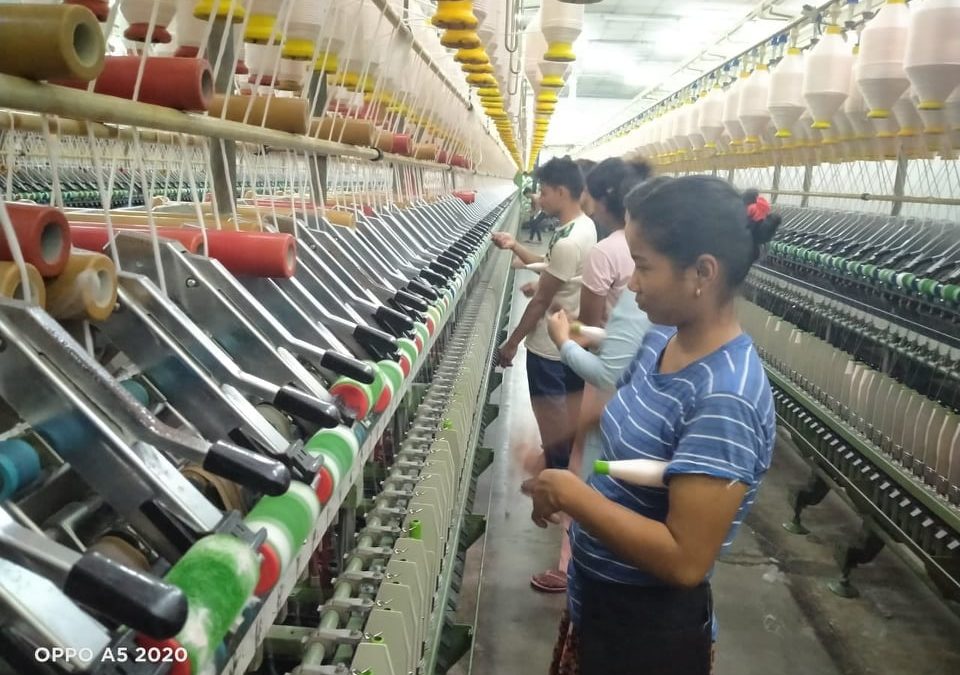In the 15 years of the history of Jagdamba Spinning Mills (JSM), JSM never had a previous history of hiring a female workforce in the factory. Skills development leading to employment project with help of Ukaid SEP partnership, from December 2020, Jagdamba achieved its breakthrough and trained and place over 130 women employees. During the pilot-project months, it envisages to train and enrol further 200 female workforces.
Jadamaba turned Bhiarawa into an industrial hub in less than fifteen years. Many leading cement production, steels, tea, spun yarn, woven fabrics, calcium carbonates and so on have been employed by the powerhouse firm. In spinning yarn, however, they only had a decade of recruiting skilled Indian employees because of the lack of skilled local labor. Workforce turnover has provided JSM with a challenge. The cost of losing and substituting a single employee was equivalent to more than twice the salary of the employee, with costs rising further depending on the seniority of the leaving employee. Synthetic Jagdamba alone produced more than 15,000 skilled employees, with only 500 workers remaining. Jagdamba needs 700 workers to operate operations to the fullest each day.
Skilled labour fleeing back to home nations was the main obstacle for JSM. A persistent obstacle to maximum productivity was high employee turnover. Therefore, by training local workers and hiring female employees on board to minimize the loss and overcome the void, JSM institutionalized a plan of transition by making gender diversity a priority. Making gender diversity a business goal eventually, will lead to financial benefits and help an organization achieve its full potential.
Management discussed and planned the inspection route before hiring women onboard. The internal management carefully studied effective workforce transition. Until deciding to employ women on board, access to quality and building a sustainable infrastructure was an important determinant for JSM. In planning onboarding, a significant amount of time was taken as JSM wanted to institutionalize a new strategy and could not employ women in as similar way employing men. Without understanding potential separate effects on women and men according to their needs, just as men do.
The first cornerstone of an integrated approach was to take into account the unique gender dimensions of infrastructure plans, shifts, and policies and change management institutionalization. It included recognizing the needs of women and ensuring that the transition takes place well for current male workers.
JSM currently has separated washrooms, changing rooms and transportation services provided for the female workers. Jagdamba is operating the Bhairahawa- Factory- Bhairahawa and Lumbini- Factory- Lumbini route from December for the convenience of women trainees. Also, Jagdamba has dedicated a building for women’s residence, developing a separate canteen, investing in building proper dedicated washrooms and changing rooms. JSM has also implemented an NYMA safeguarding policy to mitigate the risks at work.
It’s only from December 2020, since women workforce intake; Management has, however, already started to see the apparent difference. A bastion of the convention has broken down women’s vocational skills to make way for sweeping changes where local Nepalese women achieve their rightful position as an integral part of the formal workforce. Women are very committed and honest in comparison; they are also fast learners. They don’t abandon machines and go as men do for regular short frequent breaks. Less chat, no smoking, less frequent recreational breaks, higher attendance. No abrupt quitting jobs or opting for the foreign labour market as opposed to men workforce. Management admits that women’s job productivity is much higher than men’s. Managers are also very satisfied with their decision, as they prove to be very responsible.
Maintenance of spare parts and machines typically cost JSM a great deal. Machines, however, are planned for a long lifespan, but each needs some care and maintenance to reach its life expectancy. Women workers have been handling machines that properly store power tools, conducting maintenance as required, and providing more value upon their involvement. In the initial days, women were faced with operating machine problems. There was a lot of waste, and there were comparatively poor production and quality. This was expected, however, by management. Management, however, is very surprised at their learning speed, they are fast learners.
During the Covid 19 pandemic, JSM endured several hardships. Nearly 50% of Indian skilled migrant workers started walking back home. As a result, there was a minimum JSM output rate. Covid 19, however, proved to be beneficial in training and local labour placement that dramatically decreased high turnover, lowering JSM’s recruitment costs. Covid 19 downfalls benefited JSM in adequate inclusive and local workforce planning and development.
JSM has sparked towards equality. It has encouraged women to move from the domestic world to a more autonomous environment in the public sphere.JSM does, however, need an effective recruiting plan that improves gender diversity in these job positions without adversely impacting existing co-worker relationships.NYMA plans to upskill these women in supervisory positions in the coming days, potentially leading them to become trainers in these factories. It is one of NYMA’s proven inclusive goals, keeping management accountable for diversity in all partnering sectors, creating a more engaged community that encourages men and women to develop trusting relationships and motivates them to perform at a higher level.


Recent Comments